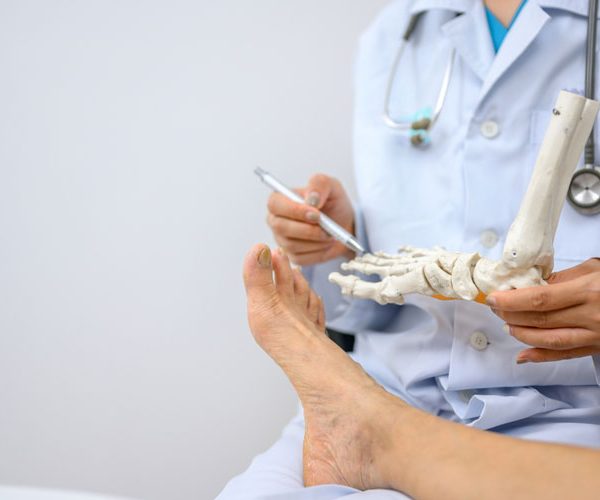Bone health is a crucial aspect of overall well-being, and as clinicians, it’s our responsibility to educate and empower patients about controllable risk factors that can influence their bone health. It’s helpful to understand the importance of effective communication between clinicians and patients regarding diet, physical activity, body weight, tobacco and alcohol use, and medications that can compromise bone health. Additionally, portable bone density scanners play an important role in helping clinicians manage and monitor their patients’ bone health. By combining communication with advanced screening technologies, we can work collaboratively to prevent bone-related issues empowering bone health and the quality of life for patients.
The Role of Diet in Bone Health
A well-balanced diet is vital for maintaining strong and healthy bones. Clinicians should emphasize the importance of consuming calcium-rich foods, such as dairy products, leafy greens, and fortified non-dairy alternatives, to promote bone density. Additionally, foods high in vitamin D, like fatty fish, eggs, and fortified cereals, help enhance calcium absorption empowering bone health.
References:
National Institutes of Health. (2021). Calcium Fact Sheet for Health Professionals. https://ods.od.nih.gov/factsheets/Calcium-HealthProfessional/
The Impact of Physical Activity on Bone Health
Regular physical activity not only improves overall health but also strengthens bones. Weight-bearing exercises, such as walking, jogging, and resistance training, stimulate bone formation and increase bone density. Clinicians should counsel patients on incorporating these activities into their daily routines to promote optimal bone health. Hejazi, K., Askari, R., & Hofmeister, M. (2022). Effects of physical exercise on bone mineral density in older postmenopausal women: a systematic review and meta-analysis of randomized controlled trials. Archives of osteoporosis, 17(1), 102. https://doi.org/10.1007/s11657-022-01140-7
Body Weight and Its Connection to Bone Health
Maintaining a healthy body weight is essential for bone health. Both obesity and being underweight can negatively impact bone density and increase the risk of fractures. Clinicians should engage in open discussions with patients about achieving and maintaining a healthy weight through a balanced diet and regular physical activity. Eytan, S., Shafer, A. (2023). What to Know About Obesity and Bone Health. HealthCentral. https://www.healthcentral.com/condition/obesity/obesity-and-bone-health
Tobacco and Alcohol Use: Detrimental Effects on Bone Health
Tobacco and excessive alcohol consumption have detrimental effects on bone health. Smoking reduces blood flow to bones, impairs bone-forming cells, and accelerates bone loss. Also, smoking impairs calcium absorption, resulting in decreased bone density and weakened bones. Nicotine hinders the production of essential bone-forming cells, critical for proper healing. And, smoking accelerates the breakdown of estrogen, a vital component for building and maintaining a healthy skeleton. Al-Bashaireh, A. M., Haddad, L. G., Weaver, M., Chengguo, X., Kelly, D. L., & Yoon, S. (2018). The Effect of Tobacco Smoking on Bone Mass: An Overview of Pathophysiologic Mechanisms. Journal of osteoporosis, 2018, 1206235. https://doi.org/10.1155/2018/1206235
Similarly, excessive alcohol intake interferes with bone formation and increases the risk of fractures.
Yamin Ke, Huifang Hu, Jinli Zhang, Lijun Yuan, Tianze Li, Yifei Feng, Yuying Wu, Xueru Fu, Mengmeng Wang, Yajuan Gao, Weifeng Huo, Yaobing Chen, Wenkai Zhang, Longkang Wang, Xi Li, Jinyuan Pang, Zeqiang Zheng, Fulan Hu, Ming Zhang, Liang Sun, Yang Zhao, Jie Lu, Dongsheng Hu. (2023). Alcohol Consumption and Risk of Fractures: A Systematic Review and Dose–Response Meta-Analysis of Prospective Cohort Studies. Advances in Nutrition. Volume 14, Issue 4. 2023. Pages 599-611. ISSN 2161-8313. https://doi.org/10.1016/j.advnut.2023.03.008. Clinicians should emphasize the importance of quitting smoking and moderating alcohol consumption to improve bone health.
Medications and Their Impact on Bone Health
Certain medications can compromise bone health by reducing bone density or increasing the risk of fractures. For example, long-term use of corticosteroids can lead to osteoporosis. Other drugs that can negatively affect bone health include hormone altering medications, anti-depressants, acid blockers and anti-seizure or anti-convulsant medications. Clinicians must inform patients about the potential side effects of medications and discuss strategies to minimize their impact on bone health, such as supplementing with calcium and vitamin D as well as taking other measures such as engaging in weight bearing exercise.
Mercurio, M., de Filippis, R., Spina, G., De Fazio, P., Segura-Garcia, C., Galasso, O., & Gasparini, G. (2022). The use of antidepressants is linked to bone loss: A systematic review and metanalysis. Orthopedic reviews, 14(6), 38564. https://doi.org/10.52965/001c.38564, Briot, K., & Roux, C. (2015). Glucocorticoid-induced osteoporosis. RMD open, 1(1), e000014. https://doi.org/10.1136/rmdopen-2014-000014, Lespessailles, E., & Toumi, H. (2022). Proton Pump Inhibitors and Bone Health: An Update Narrative Review. International journal of molecular sciences, 23(18), 10733. https://doi.org/10.3390/ijms231810733, Ziemba, K. (2022). Bone Health. Impact of Antiseizure Medication. Epilepsy Foundation. https://www.epilepsy.com/complications-risks/bone-health#:~:text=Many%20studies%20have%20shown%20an,and%20valproic%20acid%20(Depakote).
Portable Bone Density Scanners: A Revolutionary Tool for Bone Health Management
Portable bone density scanners offer a groundbreaking solution for patients and clinicians. These handheld devices use ultrasound technology to measure bone density at peripheral skeletal sites, such as the wrist. By providing instant results, portable screenings enable clinicians to assess bone health conveniently and efficiently, even in primary care settings.
Portable bone density screenings not only offer accessibility but also empower patients with tangible bone health information. By sharing instant results with patients during their appointments, clinicians can engage in more meaningful discussions about their bone health status. Seeing actual measurements can motivate patients to make positive changes in their lifestyle, adhere to treatment plans, and take preventive actions.
Early detection of low bone density or signs of bone loss provides an opportunity for timely intervention and preventive measures. This proactive approach can significantly reduce the risk of fractures and the progression of osteoporosis.
Good Communication and Empowering Bone Health: the Keys to Promoting Bone Health
Effective communication between clinicians and patients lays the groundwork for successful bone health management. By discussing controllable risk factors and providing evidence-based recommendations, clinicians empower patients to take charge of their bone health. Moreover, the advent of portable bone density scanners has revolutionized bone health assessment, offering accessibility, early detection, and progress monitoring. These handheld devices enable clinicians to integrate bone density screening seamlessly into routine check-ups, enhancing patient engagement and treatment outcomes. By combining communication with advanced screening technologies, clinicians can lead their patients towards a more proactive approach to bone health, promoting healthier and more fulfilling lives. Empowering bone health an helping patients to be armed with knowledge and convenient bone density screening results, can take steps to prevent bone-related issues and embrace a higher quality of life.












